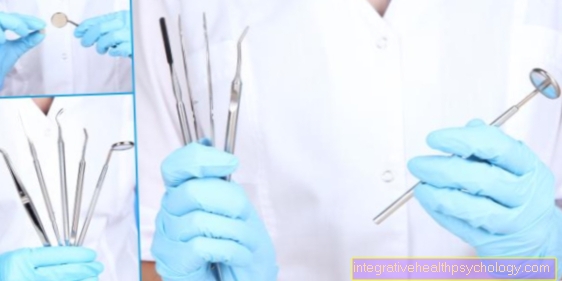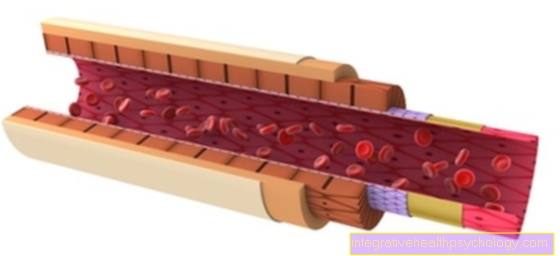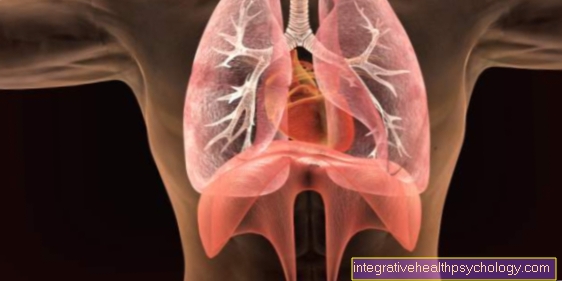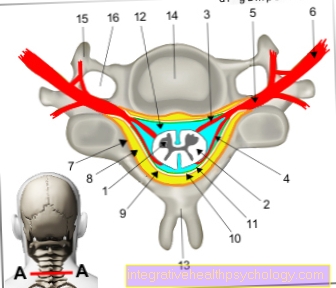Abscess in the neck
introduction
An abscess in the neck is also known as a boil. The abscess is caused by inflammation, mostly caused by bacteria. In the neck, the pathogens reach the hair follicle along the hair shaft and cause inflammation of the surrounding tissue. The infection causes tissue meltdown and accumulations of pus, which, together with the bacteria, collect within a capsule and thus form an abscess. An abscess on the neck can be the size of a common pus pimple and be relatively harmless. If the inflammation spreads, the abscess can become the size of a golf ball and cause severe discomfort.
You might also be interested in the topic: Boils in the neck

Symptoms of an abscess in the neck
The main symptom of an abscess is the several centimeter large lump that lies either superficially or deeply in the tissue. The yellow pus collection can typically be seen in the middle of the knot. The skin around the abscess is severely swollen, red and warm from the inflammation. An abscess in the neck can cause severe throbbing pain and the severe swelling of the tissue makes the entire affected area very sensitive to pressure.
With larger abscesses, a general feeling of malaise and fatigue are added to the symptoms. If the inflammation spreads into the surrounding tissue or if several boils merge into a so-called carbuncle, those affected react with a fever and severely swollen lymph nodes. In such a case, a doctor must be consulted immediately so that the inflammation does not spread in the body and lead to serious complications. If the pathogens get from the abscess into the bloodstream, blood poisoning occurs, a serious illness that can lead to organ failure and death within a very short time.
You can find more information on the topic here: Abscess
Pain
An abscess in the neck can be very uncomfortable and cause great pain. Due to the infection, the skin in the affected area is very sensitive to pressure and the severe swelling causes pain. The severity of the pain depends on the location and size of the abscess. After the boil is surgically opened, the accumulated secretion drains away, the pressure on the surrounding tissue is reduced and the pain disappears relatively quickly.
Therapy for an abscess
A boil in the neck must not be pushed around without authorization, as this will squeeze the bacteria deeper into the tissue and get into the bloodstream. The bacteria in the blood cause serious complications, such as blood poisoning or a brain abscess, which can be fatal.
For these reasons, an abscess should only be treated by a doctor who will cut open the boil and allow the pus to drain. The wound is thoroughly rinsed with an antiseptic solution. In the case of small abscesses, the treatment is completed and the cut wound heals quickly. In the case of larger and deep abscesses, drug therapy must also be given. The doctor can take a smear of the purulent secretion to determine the exact bacterial pathogen and prescribe a suitable antibiotic. Usually, however, the pathogen detection is not waited for and the patient is prescribed a broad spectrum antibiotic that is directed against the common bacterial strains after opening. The drug must be taken for several days to prevent the bacteria from spreading again and forming an abscess in the same place again.
Read more on the topic: Abscess treatment
Length of time it takes to heal a neck abscess
The duration of an abscess on the neck depends on the size of the boil and the spread of the inflammation. Sometimes the abscess will open on its own as the disease progresses and the pus can drain away. In the case of very large or deep abscesses, the collection of pus must be opened by a doctor. After the pus with the bacteria has drained, the wound heals without complications within a few days.
Read more on the topic: Healing an abscess
Causes of a Neck Abscess
In most cases, the cause of an abscess in the neck is inflammation of the hair follicle. The typical pathogen causing abscesses is the bacterium Staphylococcus aureus, which occurs in the natural skin flora on the body. The bacteria reach the deep layers of the skin via the hair shaft and cause an inflammatory reaction there. The infection melts inflamed tissue and creates a cavity filled with pus - the abscess.
The bacteria get into the tissue more easily if the skin is already damaged by minor injuries or mechanical stress, such as abrasive collars or chains. The development of abscesses is also promoted by a weakened immune system and immunosuppressed people, such as poorly adjusted diabetics, cancer sufferers or people after transplants, are often particularly prone to abscesses. Furthermore, poor personal hygiene promotes the formation of abscesses.
Diagnosing an abscess in the neck
The doctor makes the diagnosis of a superficial abscess in the neck simply by looking at the typical skin changes. The painful lump with the characteristic yellowish pus head in the middle is typical of an abscess. For deep abscesses, the doctor can determine the size and spread of the inflammation using an ultrasound scan. A blood test can be used to determine the inflammation values (leukocytes, CRP) in the body.
Other locations
Abscesses can occur not only in the neck, but also, for example, in the side of the neck.
Abscess on the neck
An abscess in the neck area is usually located in the neck, but sometimes a boil can also form on the side of the neck. An abscess on the neck can have many causes. Small pimples and ingrown hairs often appear in men after shaving, which can later develop into an abscess. Inflammations that have already developed in the head area, such as purulent tonsillitis or otitis media, can also spread to the tissue of the neck and lead to abscess formation.
Read more on the subject below: Abscess on the head
The neck is a sensitive area as important vessels and nerve tracts, such as the carotid arteries and the jugular veins, run in this area between the head and the body. Therefore, an abscess on the neck usually requires treatment. Depending on the location, the doctor cuts the bump open under local or general anesthesia and then prescribes antibiotic therapy.
Read more on the topic: Neck abscess - is it dangerous?





























